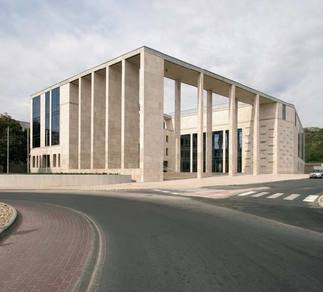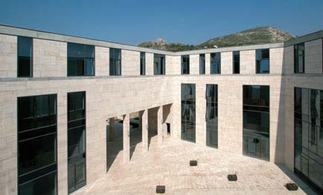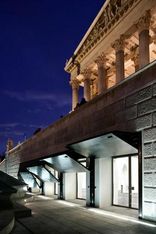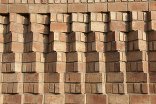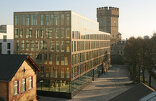Bauwerk
Town Hall Budaörs
ZSK Architects - Budaörs (H) - 2005

Town hall, Budaörs
In a hilly suburb of Budapest, Zsuffa and Kalmár have designed a town hall in the form of an „artificial rock“
10. März 2006 - Emiel Lamers
On the west side of the Hungarian capital lies the originally Swabian town of Budaörs. Since the political changes, this Budapest suburb has been best known for the American-style succession of big foreign chains strung out along the motorway to Vienna. The old, small-scale town centre, with a mere 25,000 inhabitants, is less well known. Two years ago the SDS liberal party held a national competition for an extension to the existing town hall. Out of the 40 submitted plans, the rather classical design from the young practice of Zsolt Zsuffa and Lásló Kalmár was awarded first prize.
The former town hall was housed in a no-nonsense office block and set sideon to the ribbon development of Budaörs. The competition guidelines required inclusion of the existing office in the new design. The architects found hardly any references in the immediate surroundings with which to link their design and instead drew their inspiration from the characteristic rocky hills around the town. The design can be interpreted as an artificial rock that has come rolling down one of those hills. On the outside the „rock“ is solid, on the inside hollow, with the council chamber and lobby in the core.
In their competition design, the architects proposed cladding the facade with stone from the local quarry. That idea fell through when the stone proved not to meet the required quality standards. However, locally-quarried gravel has been used as ballast on the flat roof, so that from the hilltop the building does have a solid, rock-like presence. Travertine – imported from Turkey in view of the highly competitive price – has now been used for the cladding and the floors. Unfortunately, for financial reasons, the contractor and the client opted for open joints. The architects would have preferred closed joints which would have given the building a more solid appearance.
The town hall can be approached either from the street side below, or from the parking lot higher up. On the street side, a four-storey portico demarcates a large public forecourt. With the spectacular dimensions of the colonnade the architects sought to give the building a more formal and more public presence than the previous, neutral office block.
From the forecourt, citizens enter the building centrally, into a double-height lobby. The lobby can also be accessed from the parking lot, through the second entrance. In that case, the visitor descends beside a narrow watercourse flowing across a ridged concrete surface which makes for a pleasantly soothing sound. The architects also made use of sloping site here to make ten tiered wooden benches, thereby satisfying the municipality’s schedule of requirements, which included a number of public spaces for cultural events. The visitor continues on below the envelope of the building and arrives in an enclosed courtyard. Recently it was decided to hold marriage ceremonies here in good weather.
Above the lobby is the heart of the building: the council chamber. The chamber is open to the street side and has a high strip of fenestration reaching to the top floor of the building where the municipal executive has its offices. Halfway up the existing building, one of the offices has been taken out, opening up the central corridor and allowing plenty of light to enter the building at that spot. The marriage room is situated on the first floor of the new section. The architects have sought to give it an ambience somewhere between a chapel and a sitting room. The same applies to the table from behind which the registrar conducts the marriage ceremony – according to Kalmár it is a cross between a kitchen table and an altar. In the end, Zsuffa and Kalmár succeeded in providing Budaörs with a fullfledged, accessible and timeless town hall with a very limited building budget (800 euros/m², incl. VAT). The young architects claim they do not like „fashionable“ architecture, but try to design buildings with a timeless presence. They are currently working on a competition for a site across the road from the town hall. Should they win, the „rathaus“ will undoubtedly find more appropriate references in its immediate surroundings!
The former town hall was housed in a no-nonsense office block and set sideon to the ribbon development of Budaörs. The competition guidelines required inclusion of the existing office in the new design. The architects found hardly any references in the immediate surroundings with which to link their design and instead drew their inspiration from the characteristic rocky hills around the town. The design can be interpreted as an artificial rock that has come rolling down one of those hills. On the outside the „rock“ is solid, on the inside hollow, with the council chamber and lobby in the core.
In their competition design, the architects proposed cladding the facade with stone from the local quarry. That idea fell through when the stone proved not to meet the required quality standards. However, locally-quarried gravel has been used as ballast on the flat roof, so that from the hilltop the building does have a solid, rock-like presence. Travertine – imported from Turkey in view of the highly competitive price – has now been used for the cladding and the floors. Unfortunately, for financial reasons, the contractor and the client opted for open joints. The architects would have preferred closed joints which would have given the building a more solid appearance.
The town hall can be approached either from the street side below, or from the parking lot higher up. On the street side, a four-storey portico demarcates a large public forecourt. With the spectacular dimensions of the colonnade the architects sought to give the building a more formal and more public presence than the previous, neutral office block.
From the forecourt, citizens enter the building centrally, into a double-height lobby. The lobby can also be accessed from the parking lot, through the second entrance. In that case, the visitor descends beside a narrow watercourse flowing across a ridged concrete surface which makes for a pleasantly soothing sound. The architects also made use of sloping site here to make ten tiered wooden benches, thereby satisfying the municipality’s schedule of requirements, which included a number of public spaces for cultural events. The visitor continues on below the envelope of the building and arrives in an enclosed courtyard. Recently it was decided to hold marriage ceremonies here in good weather.
Above the lobby is the heart of the building: the council chamber. The chamber is open to the street side and has a high strip of fenestration reaching to the top floor of the building where the municipal executive has its offices. Halfway up the existing building, one of the offices has been taken out, opening up the central corridor and allowing plenty of light to enter the building at that spot. The marriage room is situated on the first floor of the new section. The architects have sought to give it an ambience somewhere between a chapel and a sitting room. The same applies to the table from behind which the registrar conducts the marriage ceremony – according to Kalmár it is a cross between a kitchen table and an altar. In the end, Zsuffa and Kalmár succeeded in providing Budaörs with a fullfledged, accessible and timeless town hall with a very limited building budget (800 euros/m², incl. VAT). The young architects claim they do not like „fashionable“ architecture, but try to design buildings with a timeless presence. They are currently working on a competition for a site across the road from the town hall. Should they win, the „rathaus“ will undoubtedly find more appropriate references in its immediate surroundings!
Für den Beitrag verantwortlich: A10
Ansprechpartner:in für diese Seite: Hans Ibelings
